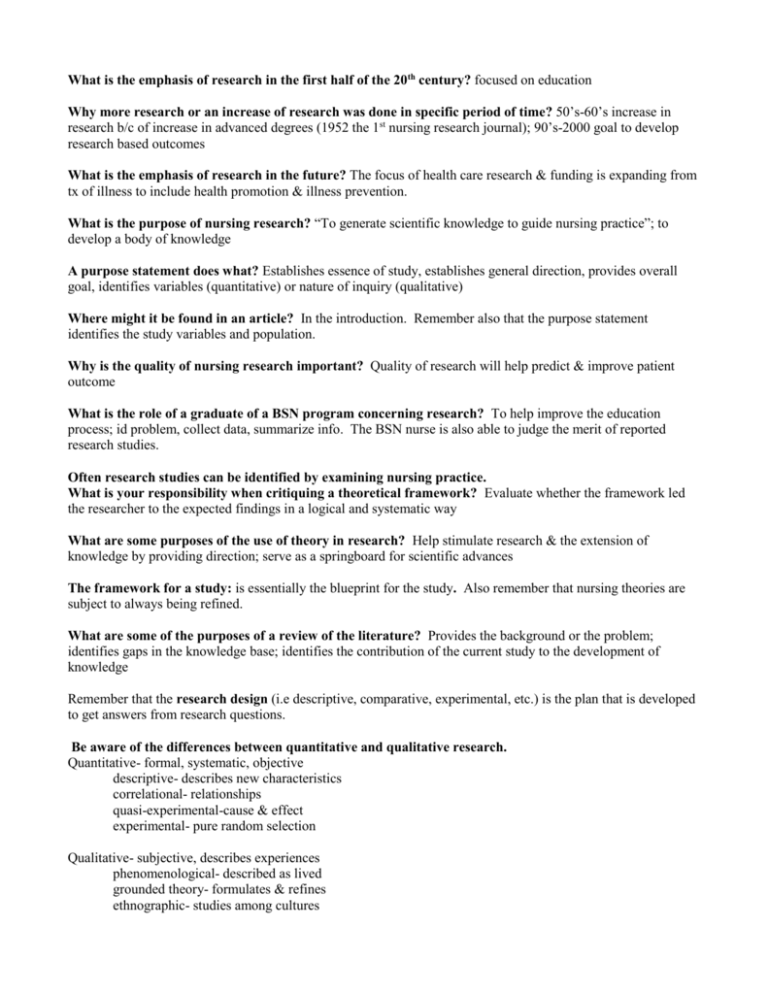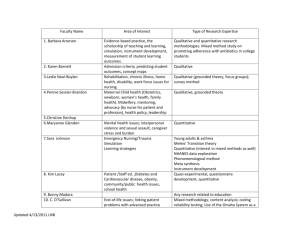NS309 Quiz1 - WordPress.com
advertisement

What is the emphasis of research in the first half of the 20th century? focused on education Why more research or an increase of research was done in specific period of time? 50’s-60’s increase in research b/c of increase in advanced degrees (1952 the 1st nursing research journal); 90’s-2000 goal to develop research based outcomes What is the emphasis of research in the future? The focus of health care research & funding is expanding from tx of illness to include health promotion & illness prevention. What is the purpose of nursing research? “To generate scientific knowledge to guide nursing practice”; to develop a body of knowledge A purpose statement does what? Establishes essence of study, establishes general direction, provides overall goal, identifies variables (quantitative) or nature of inquiry (qualitative) Where might it be found in an article? In the introduction. Remember also that the purpose statement identifies the study variables and population. Why is the quality of nursing research important? Quality of research will help predict & improve patient outcome What is the role of a graduate of a BSN program concerning research? To help improve the education process; id problem, collect data, summarize info. The BSN nurse is also able to judge the merit of reported research studies. Often research studies can be identified by examining nursing practice. What is your responsibility when critiquing a theoretical framework? Evaluate whether the framework led the researcher to the expected findings in a logical and systematic way What are some purposes of the use of theory in research? Help stimulate research & the extension of knowledge by providing direction; serve as a springboard for scientific advances The framework for a study: is essentially the blueprint for the study. Also remember that nursing theories are subject to always being refined. What are some of the purposes of a review of the literature? Provides the background or the problem; identifies gaps in the knowledge base; identifies the contribution of the current study to the development of knowledge Remember that the research design (i.e descriptive, comparative, experimental, etc.) is the plan that is developed to get answers from research questions. Be aware of the differences between quantitative and qualitative research. Quantitative- formal, systematic, objective descriptive- describes new characteristics correlational- relationships quasi-experimental-cause & effect experimental- pure random selection Qualitative- subjective, describes experiences phenomenological- described as lived grounded theory- formulates & refines ethnographic- studies among cultures historical- narrative, descriptive Also, how do steps of quantitative research compare with the steps in the Nursing process? Nursing Research is an example of one of the journals that might contain a high number of primary sources (original researcher vs. someone who just reports on a primary study—secondary source). Be aware of what a demographic variable is. characteristic or attribute of the subject that are collected to describe the sample identify independent and dependent variables. *changes in the dependent variable are presumed to be caused by the independent variable Remember that this pertains to studies that look for a cause and effect relationship i.e. quasi-experimental or experimental studies. A descriptive study, for example, will not have an independent variable. independent variable: is something you do (i.e. teaching) to see if it has an effect on something else; stimulus or activity that is manipulated or varied by the researcher to create an effect on the dependent variable dependent variable: response, behavior or outcome that the researcher wants to predict or explain random sampling, decreases bias and helps to implement control. Types of hypothesis (null, directional, etc.). Associative vs Causal -associative- identifies variables that occur or exist together in the real world, such that when one variable changes, the other changes -causal- states the relationship between two variables, in which one variable is thought to cause or determine the presence of the other variable Simple vs Complex -simple- states the relationship between two variables -complex- predicts the relationship among three or more variables Nondirectional vs Directional -nondirectional-states that a relationship exists but does not predict the exact nature of the relationship -directional- states the specific nature of the interaction or relationship between two or more variables Research vs Null -research- states what the researcher thinks is true -null- states no difference or relationship exist Three levels of research questions (as far as rewriting hypotheses to a research question). Level I- “what is…” or “what are…” questions; designed to elicit descriptions of a single topic or population; exploratory by nature; describes something Level II- “what is the relationship between…” questions; focus on relationships between two or more variables Level III- asks why the relationship developed in level II exists; seek to predict that one variable influences the other in a certain way; try to establish a cause and effect relationship What are the problems and purposes of a study? The problem is the reason for the study A purpose statement establishes essence of study, establishes general direction, provides overall goal, identifies variables (quantitative) or nature of inquiry (qualitative)






